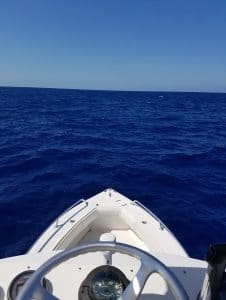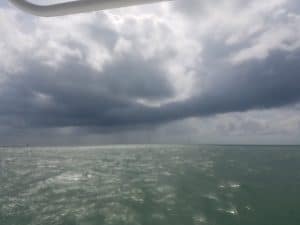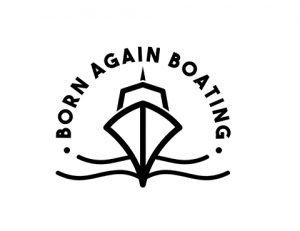After you have spent quite a bit of time on the water, you will eventually end up hitting the ground! Don’t worry; it happens to all of us eventually. Most of the time it is not a big deal, but it could be depending on the circumstances!
What to Do When You Run Aground In a Boat? Depending on how badly you run aground, have everyone move to the back of the boat and try to reverse off. In the event of a hard grounding, have everyone get out of the boat to lighten the load. Then try to back off.
There are many different situations when it comes to running aground in a boat, here is what you need to know to do in many of these situations!
What Does It Mean To Run Aground On A Boat?
The word “aground” is pretty self-explanatory. When you end up losing control and part of your hull makes contact with the ground, your boat has run aground.
 Your boat runs aground when it ends up on the shore, on the flats, or beached on a sandbar. Basically when you are travelling across extremely shallow waters. And the bottom of the boat makes contact with the rocks or reefs under the water.
Your boat runs aground when it ends up on the shore, on the flats, or beached on a sandbar. Basically when you are travelling across extremely shallow waters. And the bottom of the boat makes contact with the rocks or reefs under the water.
There is no shame in admitting that you have run your boat aground. Anyone that spends enough time on the water will run their boat aground.
If you spend enough time out on the water, you are bound to run aground once or twice in your lifetime. It’s just part of boating!
However, you must try and not make a habit out of running aground! This does have the potential to seriously harm the boat. The subsequent repairs can be extremely long and costly.
And with your boat in the mechanic’s workshop, you will not be able to enjoy your time on the water.
In extreme cases, you might even have to scrap the boat entirely!
What Is The First Step To Take After Running Aground?
No matter how you run aground, you must not panic. Panic can cause the situation to worsen, and you might end up causing more harm to yourself, your passengers, or your boat if you are not thinking clearly.
 There’s an old saying for people that panic while driving the boat. Whenever you get into a tight spot, “just panic and throttle, panic and throttle!”
There’s an old saying for people that panic while driving the boat. Whenever you get into a tight spot, “just panic and throttle, panic and throttle!”
Obviously, this is not what you want to do. Staying calm and assessing the situation clearly is the best first step.
Many people just immediately slam the boat into reverse when they run aground. This is wrong. You don’t want to go immediately from forward to reverse, that is bad on the gear case.
When you realize that you have hit the ground, immediately put the boat into neutral. This prevents the boat from going further ashore and getting further damage.
After you put the boat into neutral, check that all of your passengers are okay. Try to keep calm during the process, and get your passengers to calm down, as well.
If it’s a really bad hit and the boat might be taking on water. Make sure everyone is wearing a lifejacket, and ask them to wear one, if they are not.
Once you determine that nobody is injured.
Before you do anything else, lift the outboard engine, or outdrive (if you have an inboard engine) out of the water. And make sure that there isn’t any prop damage and then put it back down in the water.
Shift the weight on the boat to the point that is farthest away from where it touches the ground. You can do this by asking all of the passengers to move to that side or back of the boat. Additionally, if you have any cargo on board, move it back as well.
This lifts the boat off the ground and makes it float in the water again. It also enables you to slowly back out and put the boat back on the water.
If you can’t back off with just the engine, try to shove off the ground with the help of a boathook or paddle, or a similar long rod.
If this does not work, sometimes when you run too far aground. Shifting the weight on the boat does not help you in breaking contact with the ground.
 In such a scenario, ask your passengers to briefly exit the boat. This helps to lighten the load and enable you to back it off, easily.
In such a scenario, ask your passengers to briefly exit the boat. This helps to lighten the load and enable you to back it off, easily.
You might need to experiment a little with shifting the weight and entirely removing it from the boat. With a little trial-and-error, you can find the perfect balance of shifted weight that allows your boat to break contact with the ground and float on the water again.
Once you are back on the water, ask your passengers to return to their original places to balance out the boat. Now, check your boat for any leaks and ensure that it is not taking on water.
Your Boat Runs Aground But You Find No Leaks: What to Do?
If the boat does not take on water, you should count your blessings. There are no leaks in the boat and you can continue to enjoy your day out on the water. Just try to not repeat the same mistake again.
However, if the boat has developed a leak, you need to cut your boating expedition short. If the leak is not too severe, you might be able to drive it to the nearest boat repair shop to get it fixed.
Just make sure to use your bilge pump to pump out the water the boat is taking in.
Additionally, it might be a good idea to drop off your passengers from the boat before you drive it to the repair shop. With less weight on the boat, it takes on less water and does not sink to the bottom of the ocean floor.
However, if the boat is taking on too much water, you might have to exit the boat and leave it where it is. Put it back up on a beach or sandbar where it won’t sink.
Then have everybody leave the boat and go ashore. But leave someone or two people behind to drop the boat anchor or tie the boat off securely to keep it in place.
Also ensure that the float switch and bilge pump are working properly while the people that went to shore to get help. This will keep the boat from taking on too much water and causing more damage.
Additionally, try to improvise and temporarily plug the leak to prevent it from taking on too much water. You can even try to shift the weight on the boat to the opposite side of the boat from where the leak is. This prevents the water from entering the boat.
After you ensure that you have tied the boat securely enough to prevent it from drifting away, call for help. If you end up stranding yourself on a deserted island, you’ll want to send an SOS for help.
What Should You Do First If Your Boat Runs Aground At High Speed?
 If you run aground at high speed, chances are that the boat is too stuck for you to remove yourself.
If you run aground at high speed, chances are that the boat is too stuck for you to remove yourself.
Additionally, in extreme cases, the impact of the crash is going to leave massive holes in the boat. Where it will begin to take on water and quickly. Usually damaging the engine as soon as impact happens.
High speed impacts are the condition where the boat is the last of our concern. These are the accidents where people can be extremely hurt and even killed.
So, the first steps to take is to ensure the health and condition of everyone that was onboard!
Discussing head impacts and other damages done to them.
Internal bleeding can be a deadly injury and not so obvious. So, make sure that everyone is ok and if there are any thoughts of serious injury. Get to the hospital or call for help to get medical assistance and checked out.
Outside of that, follow the same steps we outline previously: Put the boat in neutral, kill the engine, and call emergency services if needed. Then move onto inspecting the boat for damage.
Plug any leaks if they exist, and turn on the bilge pump. If you have run aground on land, exit the boat and tie it off, securely. Then wait for help to arrive.
What Is The Requirement For Coast Guard Assistance When A Vessel Is Aground?
 If all you require is a simple tow to get out of the situation, the Coast Guard will not come to get you. However, it is still a good idea to radio the Coast Guard and inform them who is with you and where you have run aground, in case future emergencies arise.
If all you require is a simple tow to get out of the situation, the Coast Guard will not come to get you. However, it is still a good idea to radio the Coast Guard and inform them who is with you and where you have run aground, in case future emergencies arise.
In case you or your passenger’s lives or safety is at risk, radio the Coast Guard and ask for their assistance. If your boat is sinking or if a storm is about to set in, it is always a good idea to ask for emergency assistance from the coast guard.
It’s important to remember That Boat’s Can Be Struck By Lightning!
Just remember that the coast gaurd is not Seatow or Tow-boat or US-boat. They are there for serious emergencies endangering lives.
What Is The Best Way To Avoid Running Aground In A Boat?
The best way to avoid running aground is to familiarize yourself with the terrain. Most instances of running aground occur in shallow water where the boat hits an underground reef or sandbar. Therefore, keep your eyes peeled for any markers indicating shallow waters.
However, you cannot always find markers in shallow waters in the open sea. The best way to avoid these is to familiarize yourself with the waters. Study navigational charts before you take your boat out, and keep these in your boat at all times.
If you know the depths of the water you are running into, you can steer the boat in a steady and peaceful course.
Another way to learn about the waters is to ask the local mariners about it. They can warn you of any shallow waters you might encounter so you can be more careful.
Try to keep your boat in a clearly marked channel. Look out for buoys and beacons to know where the waters are safe and where there might be hazards in the water. Study the US Coast Guard’s guide to beacons and buoys so you know the meaning behind them.
Additionally, stay alert when you are piloting the boat. The sea is beautiful, and it is very tempting to get caught up in the peace of the waters.
However, as the captain of the boat, it is your responsibility to ensure your own safety as well as the safety of your passengers. Keep your eyes peeled for any potential hazards when you are driving the boat.
It is also a good idea to keep your boat at a reasonable speed, especially when you are in unfamiliar waters. This gives you more time to spot any potential dangers.
Moreover, slower speeds also prevent much of the hassles associated with running aground at much higher speeds. This prevents severe injuries to your passengers, as well as major damages to your boat in case of running aground.
Slow speeds even allow you to react quickly when you run aground and prevent further damages. You might be able to get yourself out of the situation without any external help.
In a nutshell, being a responsible captain allows you to avoid running your boat aground. Always remember, as captain, it is your duty to ensure the safety of everyone on board. Acting responsibly allows everyone on board to better enjoy their time out on the water.
Check Us Out!
Now that you know all about running aground on a boat and what to do. Here are some other articles that we wrote that you will find extremely helpful and informational!
Why Won’t My Outboard Boat Engine Turn Over!?
How To Inspect A Boat Before Buying & Avoid Buying Someone’s Problem!
We’d also like to invite you to check out Our YouTube Channel! We create all kinds of How-To and DIY boating videos to help you learn more and more about your boat and how it works!
